Table of Contents
Eukaryotic cells are one of the two main types of cells, the other being prokaryotic cells. Eukaryotic cells are more complex and structurally organized compared to prokaryotic cells. They have a true nucleus containing genetic material enclosed in a nuclear envelope, as well as various membrane-bound organelles such as the endoplasmic reticulum, Golgi apparatus, mitochondria, and lysosomes.
Eukaryotic cells are typically found in organisms within the domain of eukarya, including animals, plants, fungi, and protists, while Prokaryotic Cells are found in bacteria and archaea. It is one of the important topics of the Biology syllabus.
Definition of Eukaryotic Cell
An eukaryotic cell is a type of cell that processes a well-defined nucleus enclosed within a membrane, along with other membrane-bound organelles like mitochondria, endoplasmic reticulum, and Golgi apparatus. Eukaryotic cells are more complex than prokaryotic cells (like bacteria) and are found in organisms within the domains of eukarya, including animals, plants, fungi, and protists. They are characterized by their compartmentalized structure and ability to carry out various specialized functions within these organelles.
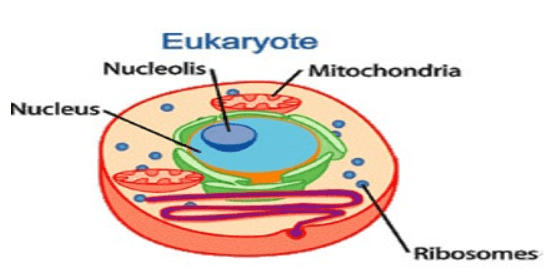
Diagram of Eukaryotic Cells
The diagram of a eukaryotic cell illustrates the structure and organelles found in complex, membrane-bound cells. It typically shows the nucleus containing the genetic material, surrounded by the nuclear envelope. Other organelles like the endoplasmic reticulum, Golgi apparatus, Mitochondria, and lysosomes are often depicted, along with the plasma membrane. This visual aid helps convey how eukaryotic cells are organized and function, emphasizing their compartmentalization and specialized roles in cellular processes.
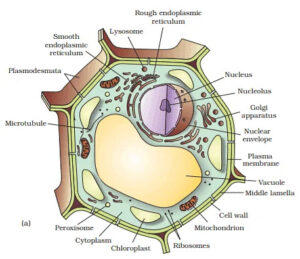
Characteristics of Eukaryotic Cell
Here we have discussed some of the characteristics of eukaryotic cells that contribute to the complexity and versatility of the eukaryotic cells, allowing them to perform a wide range of functions and adapt to diverse environments.
- Nucleus: Eukaryotic cells have a well-defined nucleus enclosed by a nuclear envelope. This nucleus contains the cell’s genetic material (DNA) in the form of chromosomes.
- Membrane-Bound Organelles: Eukaryotic cells contain various membrane-bound organelles with specific functions, including mitochondria (energy production), endoplasmic reticulum (protein and lipid synthesis), Golgi apparatus (processing and packaging of cellular products), lysosomes (digestion), and more.
- Cytoplasm: Eukaryotic cells have a cytoplasm, which is the semi-fluid material filling the cell’s interior. It contains organelles, the cytoskeleton, and the cytosol.
- Plasma Membrane: Eukaryotic cells are surrounded by a plasma membrane (cell membrane) that regulates the exchange of materials between the cell and its external environment. It is selectively permeable.
- Complex Cytoskeleton: Eukaryotic cells have a complex cytoskeleton made up of protein filaments (microfilaments, intermediate filaments, and microtubules) that provide structural support and play a role in cell motility.
- Linear Chromosomes: The DNA in eukaryotic cells is organized into linear chromosomes. This is in contrast to the circular DNA found in Prokaryotic Cells.
- Mitosis and Meiosis: Eukaryotic cells reproduce through mitosis (cell division for growth and repair) and meiosis (cell division for the production of sex cells and gametes).
- Multicellularity: Eukaryotic cells can form multicellular organisms by joining together in tissues and organs. This allows for specialization and division of labor within the organism.
- Nuclear Membrane: The nucleus of eukaryotic cells is surrounded by a double membrane called the nuclear envelope, which separates the genetic material from the cytoplasm.
- Endomembrane System: Eukaryotic cells have an extensive endomembrane system that includes the endoplasmic reticulum, Golgi apparatus, and vesicles. These organelles work together to synthesize, process, and transport proteins and lipids.
Structure of a Eukaryotic Cell
The structure of a eukaryotic cell is highly organized and compartmentalized, with various membrane-bound organelles and structures that perform specific functions. These structures are organelles that work together to maintain the cell’s functions, including growth, energy production, and response to its environment. Here is an overview of the key components and structures within a eukaryotic cell:
- Cell Membrane (Plasma membrane): The outermost boundary of the cell, composed of a lipid bilayer, which regulates the passage of substances in and out of the cell.
- Nucleus: Enclosed within a double membrane nuclear envelope, the nucleus houses the cell’s genetic material (DNA) organized into chromosomes. It controls cell activities by directing protein synthesis and cell division.
- Cytoplasm: The semi-fluid region between the nucleus and the cell membrane, containing organelles and the cytosol, where many cellular processes occur.
- Endoplasmic Reticulum (ER): A network of membranous tubule sacs involved in protein and lipid synthesis. There are two types of endoplasmic reticulum: Rough ER (studded with ribosomes, involved in protein synthesis) and Smooth ER (synthesizes lipids and detoxifies substances).
- Ribosomes: Tiny organelles (either free in the cytoplasm or attached to the rough ER) responsible for protein synthesis by translating mRNA into proteins.
- Golgi Apparatus: A stack of flattened membranous sacs that process, modify, and package proteins and lipids into vesicles for transport within or outside the cell.
- Mitochondria: The “powerhouse” of the cell, responsible for producing ATP (cellular energy) through cellular respiration. They have a double membrane, with an inner membrane that contains enzymes for ATP synthesis.
- Lysosomes: Membrane-bound vesicles containing digestive enzymes that break down waste materials, cellular debris, and foreign invaders.
- Vacuoles: Membrane-bound sacs that store water, ions, nutrients, and waste products. Plant cells typically have a large central vacuole that maintains turgor pressure.
- Cytoskeleton: A network of protein filaments (microtubules, microfilaments, and intermediate filaments) that provides structural support, facilitates cell movement, and is involved in intracellular transport.
- Centrioles: Paired organelles involved in cell division (mitosis and meiosis) and the organization of microtubules in animal cells.
- Chloroplast: Found in plant cells and some protists, chloroplasts are responsible for photosynthesis, converting light energy into chemical energy (glucose) using chlorophyll.
- Cell Wall: Present in plant cells, fungi, and some protists, the cell wall provides structural support and protection. It is made of cellulose in plants and chitin in fungi.
- Nucleolus: A distinct region within the nucleus responsible for ribosome synthesis.
- Peroxisomes: Membrane-bound organelles involved in the breakdown of fatty acids and detoxification of harmful substances.
- Nuclear Pores: Protein-lined channels in the nuclear envelope that allow the exchange of molecules between the nucleus and cytoplasm.
Examples of Eukaryotic Cell
Eukaryotic cells are found in a wide range of organisms across the domains of eukarya, which includes animals, plants, fungi, and protists. Here are some examples of organisms that consist of eukaryotic cells. These examples will illustrate the vast diversity of eukaryotic organisms on Earth, each with its own unique adaptations and characteristics, all based on the fundamental eukaryotic cell structure.
- Humans: Every cell in the human body, from skin cells to nerve cells, is eukaryotic.
- Plants: All plant cells, including those in leaves, stems, and roots, are eukaryotic.
- Animals: Animals, such as dogs, cats, and fishes, are composed of eukaryotic cells.
- Fungi: Organisms like mushrooms, yeasts, and molds consist of eukaryotic cells. Yeast cells are often used in scientific research and baking.
- Protists: Insects, like ants, butterflies, and bees, are multicellular animals made up of eukaryotic cells.
- Trees: Trees like oak, pine, and maple are composed of eukaryotic plant cells.
- Reptiles: Reptiles such as snakes, turtles, and lizards are eukaryotic organisms.
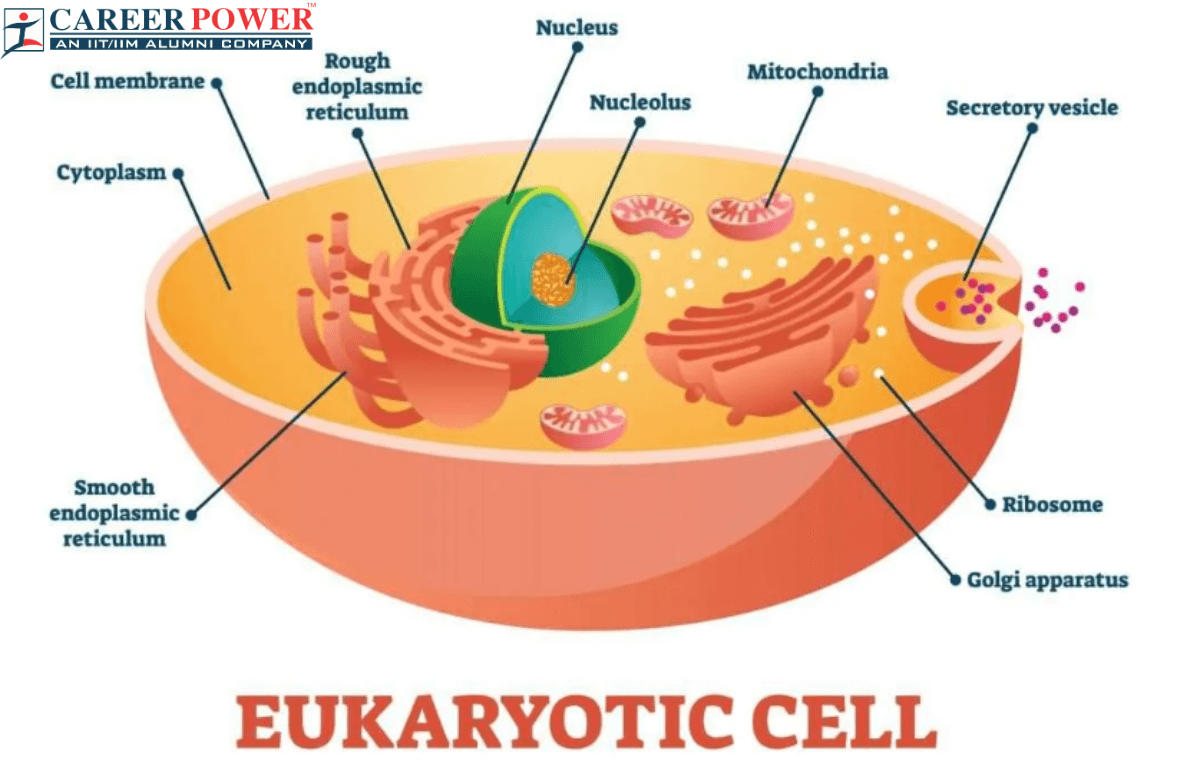
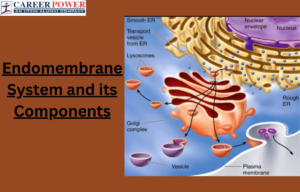 Endomembrane System - All the Organelle ...
Endomembrane System - All the Organelle ...
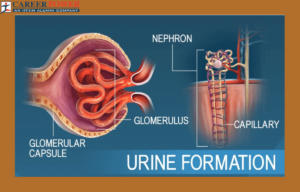 Urine Formation, Function of Tubules, Os...
Urine Formation, Function of Tubules, Os...
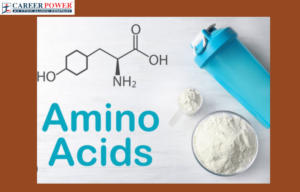 Amino Acids - List, Properties, Function...
Amino Acids - List, Properties, Function...
